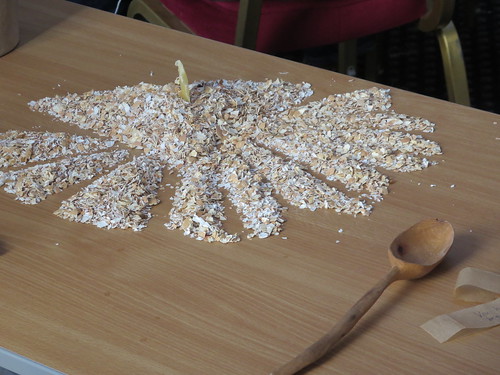Louise and Eva belong to a London-based arts programme called Fourthland, which they describe as “A movement. An idea. A place. The handheld. A way of working. A history of projects”. I’ve had the pleasure of working with them since Tessa Fitzjohn, a local curator, and Aldo Rinaldi, the Senior Arts Officer at Bristol City Council offered us the opportunity to host Fourthland as artists in residence. Together, Aldo and Tessa launched the ‘Resilience Laboratory’ in light of Bristol’s ‘Green Capital’ award – a project that aimed to explore the meaning of resilience from multiple disciplines and create a space to share learning.
Whenever I meet with Louise and Eva it feels like something profound has just happened, and is about to happen again, if I can only grasp the thoughts for long enough. They have provided a place and a time for us to stop. Think. And dwell on what it means to be resilient. The next few paragraphs are an attempt to capture just one of the many themes I found surprising and interesting at Fourthland’s most recent resilience workshop at the Cabot Institute – boredom (the good kind).
| Louise and Eva from Fourthland. Image credit Amanda Woodman-Hardy |
I have never (ever) considered boredom as a precursor to resilience, but yesterday I did. When you consider the amount of work we need to do to mitigate the effects of climate change, or tackle inequality and hunger, it’s difficult to argue that we should ever move so slowly that there’s time to be bored. The scale of the challenge is so vast that those who truly engage in the topic can almost be consumed by a constant need for progress.
In yesterday’s workshop we were set a task to work with simple materials – wax, hay, string, and eggshell – in silence. We weren’t given strict instructions on how to use the materials; just that they were ours, and we had twenty minutes to work together using silent gestures. What we learnt is that each group started the task politely – exploring the materials and gently negotiating how they might be used. We were delicate, patient, and searching for rules that might guide our behaviour. We all seemed to feel that there might be actions that weren’t ‘allowed’. After what must have been around 10 minutes there was a surge of creativity. People had become bored with their ‘safe’ tasks and began to be more provocative – breaking materials, tying furniture together, making meaningful products, or reading aloud. In this space, boredom became a catalyst for a change greater than we originally felt comfortable with. We stopped searching for rules and broke the ones we thought existed. Colleagues overcame their discomfort of physical contact, and began to share materials across their workspace. Boredom forced us to create and connect.
| In the Cabot Institute workshop, academics from social sciences, arts, engineering and science worked with simple materials from hay to wax, string to eggshells. Image credit: Amanda Woodman-Hardy |
In the post-event analysis, Louise, Eva and I discussed the possible importance of boredom in resilience and I was taken aback by their ideas. They suggest; “when we are bored, we are seeking something – something stimulating, something interesting. In this state, we become more receptive to learning.” Shima Beiji has previously argued that in order for an agent to become resilient, it must undergo a continuous process of knowledge acquisition and learning. Is boredom a condition that makes us more receptive to learning?
Perhaps, but it’s possible that we’re also open to a different kind of learning. It’s not the reductionist type of analysis that takes place after a disaster (where did the issue originate, what specifically could we have done to make it better, how can we be more resilient next time?) It’s a far more emergent way of creating understanding that intuitively feels more innovative and preventative.
If we took more time to be bored and engage in mindless repetitive tasks, could we actually be far more mindful in the present, more creative, and more resilient in the future?
In the scientific and engineering literature, it is clear that a degree of ‘redundancy’ in a system is critical for resilience. This means having additional resources or capacity that allow you to absorb shocks without compromising productivity or safety (e.g. having a store cupboard full of beans in a food shortage will mean you can avoid hunger). It seems to me that there’s a link between boredom and redundancy.
If boredom arises (in part) from repeating a task beyond the point that we can learn more from it, or enjoy it, then is boredom a form of mental ‘redundancy’? Does it give us time to absorb the mental ‘shock’ of constantly receiving new information every day?
I repeatedly hear people say they crave ‘time to really think’ away from the daily slog of tasks, but have realised that when we create this space it’s often for a defined purpose: “Think through new paper ideas – 2 hours”, or “send thoughts on strategy document to Rich – 30 mins”. Very rarely do we schedule time for unadulterated, unstructured and exploratory learning.
So what did I learn from playing with a bowl of wax this afternoon? That in order for people and communities to become resilient, we need time to be unproductive, together. That boredom can be a precursor, maybe even a catalyst, to a different kind of creation, connection and learning. That we need to trust that the use of this time will surpass our initial expectations. And that I want to work with more artists like Eva and Louise.
 |
| Hayley Shaw |
Images from the Fourthland workshop at the Cabot Institute

